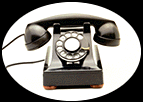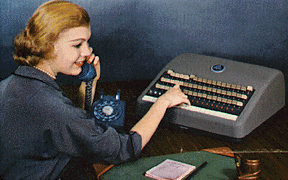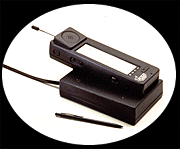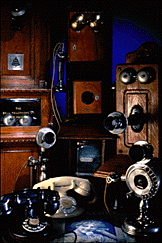
Telephones
Since the telephone was first demonstrated in 1876, it
has  evolved into a vital communications tool, providing the gateway
to the world of computer technology and information exchange.
evolved into a vital communications tool, providing the gateway
to the world of computer technology and information exchange.
Businesses were the first to use telephones, taking advantage
of the new technology to streamline their operations and maintain contact
with their suppliers. By 1920, most businesses found it nearly impossible
to survive without  the telephone, finding it more convenient and efficient than sending
messages by hand or by mail.
the telephone, finding it more convenient and efficient than sending
messages by hand or by mail.
The early office phone was a black, rotary-dial desk model, the Model 500 series, introduced by Bell Telephone Laboratories in 1949. Each individual phone had its own phone number--there was no such thing as an "extension" in the days before multilined phones. These phones were typically answered by secretaries, and a stenographer listening on another extension would take notes on the call because businessmen still wanted a written record for the files.

After World War II, increased demands on the telephone
system made it necessary to improve the technology. Radio waves, television
waves, and computer data were now being transmitted through wires designed
for voice transmission. By the 1990s, the analog-based telephone  system had been rebuilt around digital
technology. In a digital system, information about each sound wave--rather
than the sound wave itself--is sent through the wire as a numerical equivalent
and then reconstructed exactly at the other end. This new technology enables
computers--which are also based on digital technology--to "talk"
on the telephone.
system had been rebuilt around digital
technology. In a digital system, information about each sound wave--rather
than the sound wave itself--is sent through the wire as a numerical equivalent
and then reconstructed exactly at the other end. This new technology enables
computers--which are also based on digital technology--to "talk"
on the telephone.  Today, fiber-optic cables carry digital signals
at astounding rates, and they have become the backbone of the world's information
infrastructure.
Today, fiber-optic cables carry digital signals
at astounding rates, and they have become the backbone of the world's information
infrastructure.
The integration of communications and computers gave offices a vast range of new telephone services, including expanded use of 800 numbers, cellular phones, and voice mail. Often maligned as cold, impersonal, and irritating, voice mail has taken over many of what were once the secretary's duties.